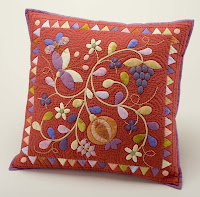.jpg)
Over the weekend, my mother and daughter (in the photo) joined me for a fun afternoon of Christmas cookie baking. One cookie tradition in our home is the making of pizzelles, a southern Italian cookie that is quickly baked in an electric "press" similar to a waffle iron. Made of flour, sugar, butter, and flavorings (we prefer anise), these crisp, lacy confections just melt in your mouth. And they are so light and pretty, I'm sure they can't have many calories - especially the broken ones where all the calories have leaked out. If you'd like my recipe and the name of my preferred pizzelle maker, just e-mail me at aqsmagazineblog@gmail.com.
By the way, my daughter also designed the adorable Play Date quilt pattern, recently published in the January 2010 issue of American Quilter magazine.
Whether your family celebrates Christmas, Hanukkah, Kwanzaa, Solstice, or just New Years, I wish you a lovely holiday season and sincere good wishes for happy quilting (and baking!) in 2010.
.jpg)





.jpg)



















.jpg)




.jpg)


















